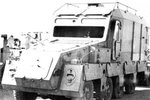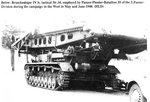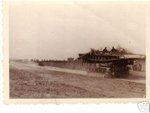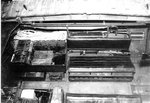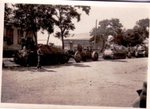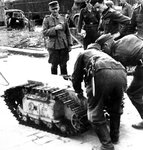Navigation
Install the app
How to install the app on iOS
Follow along with the video below to see how to install our site as a web app on your home screen.
Note: This feature may not be available in some browsers.
More options
You are using an out of date browser. It may not display this or other websites correctly.
You should upgrade or use an alternative browser.
You should upgrade or use an alternative browser.
Special Purpose Panzers.
- Thread starter CharlesBronson
- Start date
Ad: This forum contains affiliate links to products on Amazon and eBay. More information in Terms and rules
More options
Who Replied?- Thread starter
- #2
CharlesBronson
Senior Master Sergeant
Abwurfvorrichtungen on Pz.Kpfw.1

As ordered by the General der Pioniere und Festungen ( engineers and fortifications) on 28 December 1939: Through In 6 the liad of the army has ordered the rapid procurement of 100 Abwurfvorrichtungen (explosive charge dropping device) for Panzer units. These devices had already been developed, and were proven successful by Pionier-Battalion 38 of the 2.Panzer-Division.
From inside a buttoned-up Pz.Kpfw.1 it was possible to use this Abwurfvorrichtung, mounted on the rear deck, to drop explosive charges weighing up to 50 kilograms onto obstacles and barriers. The device was operated by pulling a bodwen cable.
Every Panzer-Division was to be issued 10 Abwurfvorrichtungen.
These Abwurfvorrichtungen were mounted on the rear deck of Pz.Kpfrv.1 Ausf.B. In the case of Pionier-Battalion 38, a larger version was mounted of the rear of a Pz.Kpfw.II
On 4 March 1940, orders were issued to create a Panzer-Pionier-Kompanie in each Panzer-Division Organízed in accordance with K.St.N.716 (Behelf) dated 6 March 1940, each Panzer-Pionier-Kompanie
was to have two Zerstörungszuge (destruction platoons) each with five Pz.Kpfw.1 (M.G.) (Sd.Kfz.101). Orders had already been given on 21 February 1940 to issue 11 Pz.Kpfw.1 Ausf.B to each Pionier-Battalion, one for the company commatnder and five each for the 1. and 2.Zug. The vehicle was used in France and the desert, in later teather is was not a succes because its weak armor.


As ordered by the General der Pioniere und Festungen ( engineers and fortifications) on 28 December 1939: Through In 6 the liad of the army has ordered the rapid procurement of 100 Abwurfvorrichtungen (explosive charge dropping device) for Panzer units. These devices had already been developed, and were proven successful by Pionier-Battalion 38 of the 2.Panzer-Division.
From inside a buttoned-up Pz.Kpfw.1 it was possible to use this Abwurfvorrichtung, mounted on the rear deck, to drop explosive charges weighing up to 50 kilograms onto obstacles and barriers. The device was operated by pulling a bodwen cable.
Every Panzer-Division was to be issued 10 Abwurfvorrichtungen.
These Abwurfvorrichtungen were mounted on the rear deck of Pz.Kpfrv.1 Ausf.B. In the case of Pionier-Battalion 38, a larger version was mounted of the rear of a Pz.Kpfw.II
On 4 March 1940, orders were issued to create a Panzer-Pionier-Kompanie in each Panzer-Division Organízed in accordance with K.St.N.716 (Behelf) dated 6 March 1940, each Panzer-Pionier-Kompanie
was to have two Zerstörungszuge (destruction platoons) each with five Pz.Kpfw.1 (M.G.) (Sd.Kfz.101). Orders had already been given on 21 February 1940 to issue 11 Pz.Kpfw.1 Ausf.B to each Pionier-Battalion, one for the company commatnder and five each for the 1. and 2.Zug. The vehicle was used in France and the desert, in later teather is was not a succes because its weak armor.

GrauGeist
Generalfeldmarschall zur Luftschiff Abteilung
Wow...look how small that Panzer is! 
Good stuff, thanks CB!
Good stuff, thanks CB!
- Thread starter
- #4
CharlesBronson
Senior Master Sergeant
Small but dangerous.
Brükenleger IV:
In accordance with an order from In 6 dated 22 February 1939, Krupp was to complete six Pz.Kpfw.IV chassis with modified superstructures for delivery to Wa Pruef 5 for bridgelayers. Krupp Grusonwerk of Berlin completed these six Pz.Kpfw.IV Ausf.C chassis (Fgst.Nr.80435 to 80440) in June and July 1939.
On 14 November 1939, Krupp reported that they were completing a Versuchs-Fahrzeug plus four more already contracted and requested that Magirus take over assembly of another 16.
Brückenleger IV ausf B deploying its bridge over antitank obstacles

On 16 January 1940, the "Brückenleger auf IV" were 9 meters long and that by the end of March Krupp was tocomplete two and Magirus 10 so that four divisions could each receive three. On 6 March 1940,
the first 20 Brueckenleger IV were to appear with trained crews by the end of April.
Krupp-Grusonwerk conipleted the additional Pz.Kpf IV Ausf.D chassis needed for these Brückenleger in February through April 1940. Ten of the chassis were delivered to Magirus, and Krupp kept 10 at Grusonwerk for mounting the bridgelaying equipment
All 20 Brueckenleger IV ausf b were completed by the end of April 1940.
In May of 1940 there was 20 Brueckenleger issued to units, and plans
to coriiplete another 60. One platoon in the 3.Panzer-Pionier-Kompanie ( armored assault enginneers) of the
l., 2., 3., S., and 10.Panzer-Divisions had been outfitted with four Brueckenleger.
Their employment in Belgium and France in May and June 1940 had not been very successful. By 3 June 1940, the decision had been made to cancel further Brueckenleger production and use the 16 chassis that this released to increase normal Pz.Kpfrv.IV production. However, even though the production series was canceled, a small nunmber of improved bridgelayers were ordered for experiments.
Krupp completed four Brueckenleger IV c inJanuary 1941.
All four Brueckenleger IV c were sent to the Eastern Front with the 3.Panzer-Division.
On 25 June 1941 those were used to span 18 meters across a river at an old bridge footing. Both wheeled and tracked vehicles of the Panzer-Division and part of a following motorized Division crossed the temporary bridge. wich was retrieved without difficulty.
Brükenleger IV:
In accordance with an order from In 6 dated 22 February 1939, Krupp was to complete six Pz.Kpfw.IV chassis with modified superstructures for delivery to Wa Pruef 5 for bridgelayers. Krupp Grusonwerk of Berlin completed these six Pz.Kpfw.IV Ausf.C chassis (Fgst.Nr.80435 to 80440) in June and July 1939.
On 14 November 1939, Krupp reported that they were completing a Versuchs-Fahrzeug plus four more already contracted and requested that Magirus take over assembly of another 16.
Brückenleger IV ausf B deploying its bridge over antitank obstacles

On 16 January 1940, the "Brückenleger auf IV" were 9 meters long and that by the end of March Krupp was tocomplete two and Magirus 10 so that four divisions could each receive three. On 6 March 1940,
the first 20 Brueckenleger IV were to appear with trained crews by the end of April.
Krupp-Grusonwerk conipleted the additional Pz.Kpf IV Ausf.D chassis needed for these Brückenleger in February through April 1940. Ten of the chassis were delivered to Magirus, and Krupp kept 10 at Grusonwerk for mounting the bridgelaying equipment
All 20 Brueckenleger IV ausf b were completed by the end of April 1940.
In May of 1940 there was 20 Brueckenleger issued to units, and plans
to coriiplete another 60. One platoon in the 3.Panzer-Pionier-Kompanie ( armored assault enginneers) of the
l., 2., 3., S., and 10.Panzer-Divisions had been outfitted with four Brueckenleger.
Their employment in Belgium and France in May and June 1940 had not been very successful. By 3 June 1940, the decision had been made to cancel further Brueckenleger production and use the 16 chassis that this released to increase normal Pz.Kpfrv.IV production. However, even though the production series was canceled, a small nunmber of improved bridgelayers were ordered for experiments.
Krupp completed four Brueckenleger IV c inJanuary 1941.
All four Brueckenleger IV c were sent to the Eastern Front with the 3.Panzer-Division.
On 25 June 1941 those were used to span 18 meters across a river at an old bridge footing. Both wheeled and tracked vehicles of the Panzer-Division and part of a following motorized Division crossed the temporary bridge. wich was retrieved without difficulty.
Attachments
- Thread starter
- #5
CharlesBronson
Senior Master Sergeant
- Thread starter
- #6
CharlesBronson
Senior Master Sergeant
Sd.Kfz 300 Mine clearing vehicle ( second series)
On 3 April 1940 an order was placed for a 2.Serie of 100 Minenräum-Wagen. Designated by Borgward as the "B II", it was a longer, heavier vehicle at 2.3 metric tons and powered by a larger 2.247 liter, 6-cylinder, water-cooled Borgward 6M 2.3 RTBV gasoline engine delivering 49 metric horsepower at 3300 rpm. It still had a two-speed transmission with a maximum speed of 3 km/h in first gear and 6 km/hr in 2nd. Fuel capacity was only sufficient to travel about 30 kilometers.
The walls of the hull were made out of concrete, with an armor plate added to the front to provide protection against rifle fire and fragrnents from small-caliber shells.
The "B II" could either be steered by a driver or remotely controlled by radio. Control by radio was limited to a maximum range of 2 kilometers from the command vehicle. Two Minenräum-Wagen could be steered at the same time by one comrnaiid vehicle. Up to 515 kilograms of explosives could be carried in the "B II".
Kleiner Panzerbefehlwagen 1 ( small command tank) as guiding plataform for a Sd.Kfz 300 with mine rolles attached

There was a 12 second delay in the detonation of the explosive charge after initiation by a radio signal. The explosion created a crater 1.5 meters deep and 5 meters across in a normal grasscovered field. A 300 kilogram charge detonated mines within a 40 meter diameter circle. Production of the 2.Serie of 100 Minenräum-Wagen began in July 1940.
Minenräum-Kompanie was expanded into Minenraeum-Abteilung 1 with two Minenraeum- Kompanie on 1 December 1940. Each Mineräum Kompanie with three platoons was organized in accordance with K.St.N.1159 dated 1 February 1941.
Minenräum-Abteilung 1 was first sent into action at the start of Operation Barbarossa, which began on 22 June 1941.
The use of this vehicle was not very sucessful given its limited cross-country capabilities
Sd.Kfz 300 second series in the Eastern front, june 1941
On 3 April 1940 an order was placed for a 2.Serie of 100 Minenräum-Wagen. Designated by Borgward as the "B II", it was a longer, heavier vehicle at 2.3 metric tons and powered by a larger 2.247 liter, 6-cylinder, water-cooled Borgward 6M 2.3 RTBV gasoline engine delivering 49 metric horsepower at 3300 rpm. It still had a two-speed transmission with a maximum speed of 3 km/h in first gear and 6 km/hr in 2nd. Fuel capacity was only sufficient to travel about 30 kilometers.
The walls of the hull were made out of concrete, with an armor plate added to the front to provide protection against rifle fire and fragrnents from small-caliber shells.
The "B II" could either be steered by a driver or remotely controlled by radio. Control by radio was limited to a maximum range of 2 kilometers from the command vehicle. Two Minenräum-Wagen could be steered at the same time by one comrnaiid vehicle. Up to 515 kilograms of explosives could be carried in the "B II".
Kleiner Panzerbefehlwagen 1 ( small command tank) as guiding plataform for a Sd.Kfz 300 with mine rolles attached

There was a 12 second delay in the detonation of the explosive charge after initiation by a radio signal. The explosion created a crater 1.5 meters deep and 5 meters across in a normal grasscovered field. A 300 kilogram charge detonated mines within a 40 meter diameter circle. Production of the 2.Serie of 100 Minenräum-Wagen began in July 1940.
Minenräum-Kompanie was expanded into Minenraeum-Abteilung 1 with two Minenraeum- Kompanie on 1 December 1940. Each Mineräum Kompanie with three platoons was organized in accordance with K.St.N.1159 dated 1 February 1941.
Minenräum-Abteilung 1 was first sent into action at the start of Operation Barbarossa, which began on 22 June 1941.
The use of this vehicle was not very sucessful given its limited cross-country capabilities
Sd.Kfz 300 second series in the Eastern front, june 1941
Attachments
- Thread starter
- #7
CharlesBronson
Senior Master Sergeant
- Thread starter
- #8
CharlesBronson
Senior Master Sergeant
Sd.Kfz 253, observation post:

During the late thirties trials were held of the pre-production series of the Sturmgeschütz and it was concluded that these vehicles would have to be supported by an armored ammunition carrier and observation vehicle.Thers were to be based on the Demag semi-tracked chassis.Shortly after the Sturmgeschütz had gone into production in 1940 an order for 25 le gep Beob Wg was placed and these were built between March and June 1940.
As these were the very first production vehicles using the Demag-developed D7p shortened version of the 1 ton tractor some manufacturing difficulties were experienced.
Further series were ordered as the number of Sturmgeschütz was increased , but this specialized model was abandoned in favour of the normal Sd Kfz 250.
Heavier armour and a fully-enclosed crew compartment were features of these Sd Kfz 253.Observation was from a large circular hatch in the roof.The radio aerial on the right-hand side folded forward into a protective channel when not in use.The Sd Kfz 253 served with Sturmgeschütz Batterien 640 , 659 , 660 and 665 in France in 1940 and later with other assault artillery batteries in Russia.

During the late thirties trials were held of the pre-production series of the Sturmgeschütz and it was concluded that these vehicles would have to be supported by an armored ammunition carrier and observation vehicle.Thers were to be based on the Demag semi-tracked chassis.Shortly after the Sturmgeschütz had gone into production in 1940 an order for 25 le gep Beob Wg was placed and these were built between March and June 1940.
As these were the very first production vehicles using the Demag-developed D7p shortened version of the 1 ton tractor some manufacturing difficulties were experienced.
Further series were ordered as the number of Sturmgeschütz was increased , but this specialized model was abandoned in favour of the normal Sd Kfz 250.
Heavier armour and a fully-enclosed crew compartment were features of these Sd Kfz 253.Observation was from a large circular hatch in the roof.The radio aerial on the right-hand side folded forward into a protective channel when not in use.The Sd Kfz 253 served with Sturmgeschütz Batterien 640 , 659 , 660 and 665 in France in 1940 and later with other assault artillery batteries in Russia.
Attachments
Hangwire
Airman
Wow! Thanks for the information, I never knew that the panzer chassis were so widely used in special purpose machines.
- Thread starter
- #10
CharlesBronson
Senior Master Sergeant
Thanks, actually there are a lot of special designed panzers. My intention is to give a gilmpse and some characteristics of them, to cover the topic entirely would deman a time that i dont have  .
.
more images of the observation post Sd.Kfz 253 halftrack:
- in the DAK
- 1th Panzer Div in France 1940
- Somewhere in the Eastern front, god view of the aerial mast and rear hatch.
more images of the observation post Sd.Kfz 253 halftrack:
- in the DAK
- 1th Panzer Div in France 1940
- Somewhere in the Eastern front, god view of the aerial mast and rear hatch.
Attachments
- Thread starter
- #11
CharlesBronson
Senior Master Sergeant
V2 Feurleitpanzer ( auf 8 ton zugkraftwagen)
In order to made the balistic missile A-4 ( also better know as the V2) less vulnerable to air and artillery attacks a mobile plataform was developed over the 8 ton half-track tractor. The vehicle not only served as towing plataform but also as control plataform and to fuel the rocket. ( the V2 need to be fueled prior to the launch)
The prototype "Feurleitpanzer" ( fire control armored vehicle) was equipped with an fully armored supestructure over a Büssing Nag BN 10 Zugkraftwagen 8 ton tractor.
Feuerleitpanzer, prototype

The production series using and different mounting and rear "bunker" and a non armored normal driver cab over a KM 11 chassis. Since the vehcle normally was exposed to the large blast of the propelling gasses in the V2, this armored rear section was designed to deflect the heat and protect the crew.
A total of 57 Feurleitpanzer were completed between march and november 1944, includng prototypes. This vehicles were operated with the Artillerie Abeitlung (mot) 485 and (mot) 836 of the Heer and the Werfer Abt 500 in the Waffen SS. Several rockets were launched against England and Belgium
Production vehicle

V2 control/fire room.

Despite of its mobility 3 of this vehicle were claimed as destroyed in low level attacks by USAAF fighter-bombers.
Engine: 6 cil Maybach 140 hp
Armor: 14-8 mm
Speed: 52 km/h
Weight: 11,200 kg (without V2)
In order to made the balistic missile A-4 ( also better know as the V2) less vulnerable to air and artillery attacks a mobile plataform was developed over the 8 ton half-track tractor. The vehicle not only served as towing plataform but also as control plataform and to fuel the rocket. ( the V2 need to be fueled prior to the launch)
The prototype "Feurleitpanzer" ( fire control armored vehicle) was equipped with an fully armored supestructure over a Büssing Nag BN 10 Zugkraftwagen 8 ton tractor.
Feuerleitpanzer, prototype

The production series using and different mounting and rear "bunker" and a non armored normal driver cab over a KM 11 chassis. Since the vehcle normally was exposed to the large blast of the propelling gasses in the V2, this armored rear section was designed to deflect the heat and protect the crew.
A total of 57 Feurleitpanzer were completed between march and november 1944, includng prototypes. This vehicles were operated with the Artillerie Abeitlung (mot) 485 and (mot) 836 of the Heer and the Werfer Abt 500 in the Waffen SS. Several rockets were launched against England and Belgium
Production vehicle

V2 control/fire room.

Despite of its mobility 3 of this vehicle were claimed as destroyed in low level attacks by USAAF fighter-bombers.
Engine: 6 cil Maybach 140 hp
Armor: 14-8 mm
Speed: 52 km/h
Weight: 11,200 kg (without V2)
- Thread starter
- #12
CharlesBronson
Senior Master Sergeant
Mittlere Pionerpanzerwagen Sd.kfz 251/5 215/7.
"Medium sized armored vehicle for assault engineers", it was the armored truck for the Pionere, used for carring a small 8 tons bridge with supplies and tools likes wire cutter, rope, steel wire, aditional fuel, and even explosive charges and mines.

The Sd.kfz 251 was made between 1940 and 1941 and carried no brigde. Variant 251/7 took over the job in with the rail 8 tons bridge and standarizated radio equipment Fug 5 in 1942, and was emplaced almost exclusively inside panzer divisions, between the ranks of the Pionere kompanies.
Factory fresh Sd.kfz 251/7.

The resposability to manufacture this variant layed in the firm Wesserhütte wich completed nearly 2000 Pionerpanzerwagen between 1940 and 1945.
Characteristics Mittlere Pionerpanzerwagen 251/7.
Weight combat loaded: 8180 kg
Lenght: 5,8 meters
Crew: 7 or 8
Engine : Maybach inline 6, Hl 42 100 hp.
Max speed: 50 km/h
Internal fuel: 165 liters.
Armor; 8 to 14,5 mm
Armament: 2 MG 34 with 1100rpg ( MG 42 in 1944 and onwards)
1 AT rifle PZb 40 with 40 rounds ( deleted in 1943)
5 x 3 kilograms T.N.T demolition charges.
10 x Te.Mi 42 antitank mines
20 stick grenades and 10 smoke grenades.
2 x K-98k with 125 rpg, 2 x MP-40 with 160 rpg.
Optionally a backpack flamethrower.
Inside view, the Pzb 40, rope, explosive charges, 7,92 and 9mm ammo boxes are seen.
"Medium sized armored vehicle for assault engineers", it was the armored truck for the Pionere, used for carring a small 8 tons bridge with supplies and tools likes wire cutter, rope, steel wire, aditional fuel, and even explosive charges and mines.
The Sd.kfz 251 was made between 1940 and 1941 and carried no brigde. Variant 251/7 took over the job in with the rail 8 tons bridge and standarizated radio equipment Fug 5 in 1942, and was emplaced almost exclusively inside panzer divisions, between the ranks of the Pionere kompanies.
Factory fresh Sd.kfz 251/7.
The resposability to manufacture this variant layed in the firm Wesserhütte wich completed nearly 2000 Pionerpanzerwagen between 1940 and 1945.
Characteristics Mittlere Pionerpanzerwagen 251/7.
Weight combat loaded: 8180 kg
Lenght: 5,8 meters
Crew: 7 or 8
Engine : Maybach inline 6, Hl 42 100 hp.
Max speed: 50 km/h
Internal fuel: 165 liters.
Armor; 8 to 14,5 mm
Armament: 2 MG 34 with 1100rpg ( MG 42 in 1944 and onwards)
1 AT rifle PZb 40 with 40 rounds ( deleted in 1943)
5 x 3 kilograms T.N.T demolition charges.
10 x Te.Mi 42 antitank mines
20 stick grenades and 10 smoke grenades.
2 x K-98k with 125 rpg, 2 x MP-40 with 160 rpg.
Optionally a backpack flamethrower.
Inside view, the Pzb 40, rope, explosive charges, 7,92 and 9mm ammo boxes are seen.
Attachments
- Thread starter
- #13
CharlesBronson
Senior Master Sergeant
Mörserzugmittel
Literally; mortar towing element or better translated: artillery tractor. There were several types of tanks captured by the Wehrmacht used as tractor for heavy pieces of 150mm and bigger. The conversion of a standar tank into a Mörserzugmittel was simple, it consisted in removing the turret , adding a towing brackets in the rear and sometimes covering the turret ring with canvas.
The first type was the Czech Pz 35 (t) wich was retired from service in 1945. A large quantity of french tanks were also modified for artillery towing task, mostly due the good automotive characteristics but one man turret that didnt fit into german combat tank doctrine.
There were even tractors made from T-34, however that was done only when the turret of this tank was irreparable, the T-34 a too valious combat vehicle to be wasted if fully functional.
- Morserzugmittel Matilda captured in the Eastern Front
- Morserzugmittel Somua S 35.
- Zugmittel Renault R-35 towing artillery and trucks.
Literally; mortar towing element or better translated: artillery tractor. There were several types of tanks captured by the Wehrmacht used as tractor for heavy pieces of 150mm and bigger. The conversion of a standar tank into a Mörserzugmittel was simple, it consisted in removing the turret , adding a towing brackets in the rear and sometimes covering the turret ring with canvas.
The first type was the Czech Pz 35 (t) wich was retired from service in 1945. A large quantity of french tanks were also modified for artillery towing task, mostly due the good automotive characteristics but one man turret that didnt fit into german combat tank doctrine.
There were even tractors made from T-34, however that was done only when the turret of this tank was irreparable, the T-34 a too valious combat vehicle to be wasted if fully functional.
- Morserzugmittel Matilda captured in the Eastern Front
- Morserzugmittel Somua S 35.
- Zugmittel Renault R-35 towing artillery and trucks.
Attachments
- Thread starter
- #14
CharlesBronson
Senior Master Sergeant
Leichte munitionspanzer Sd.Kfz 252.
Light Ammunition carrier based on the D7p chassis halftrack and with the 8 mm body of the recce/ observation Sd.kfz 253 .
Same engine an automotive as the Sd.253 haltrack, weight in combat order 5740 kg. Speed on road 61 km/h. Armor from 8 to 14,5 mm.
Used for suppling the Stug III batallions. 32 rounds for the 75mm "short" howitzer could be carried internally. Aditional "sonderänlage" special trailer could be towed wich added 36 rounds.
About 413 Sd.Kfz 253 were manufatured until may 1941 mostly by DEMAG, the vehicle was withdrawn from service because it could not carry the longer shells for the L-43/48 gun used in the "G" variant Stug III introduced in mid 1942.
Light Ammunition carrier based on the D7p chassis halftrack and with the 8 mm body of the recce/ observation Sd.kfz 253 .
Same engine an automotive as the Sd.253 haltrack, weight in combat order 5740 kg. Speed on road 61 km/h. Armor from 8 to 14,5 mm.
Used for suppling the Stug III batallions. 32 rounds for the 75mm "short" howitzer could be carried internally. Aditional "sonderänlage" special trailer could be towed wich added 36 rounds.
About 413 Sd.Kfz 253 were manufatured until may 1941 mostly by DEMAG, the vehicle was withdrawn from service because it could not carry the longer shells for the L-43/48 gun used in the "G" variant Stug III introduced in mid 1942.
Attachments
- Thread starter
- #15
CharlesBronson
Senior Master Sergeant
PanzermessKraftwagen
This very rare armoured vehicle of the German Wehrmacht (Panzermesskraftwagen = Armored measuring motorized vehicle) was used for the testing of artillery weapons at the shooting ranges of Kummersdorf and Hillersleben. Bsed upon the chassi and automotive of the Sd.kfz 231 recce armored car.The vision port and side armor were strengtened in order to allow close observation of the artillery impacts.
Just one or two Pzmskfw were manufactured and one was captured by the U.S Army in 1945.
This very rare armoured vehicle of the German Wehrmacht (Panzermesskraftwagen = Armored measuring motorized vehicle) was used for the testing of artillery weapons at the shooting ranges of Kummersdorf and Hillersleben. Bsed upon the chassi and automotive of the Sd.kfz 231 recce armored car.The vision port and side armor were strengtened in order to allow close observation of the artillery impacts.
Just one or two Pzmskfw were manufactured and one was captured by the U.S Army in 1945.
Attachments
- Thread starter
- #16
CharlesBronson
Senior Master Sergeant
NSU Kettenkrad, the panzer-motorcycle/ATV of the german army used by Mountain troops.
View: https://www.youtube.com/watch?v=dZQNBI5hvqM
View: https://www.youtube.com/watch?v=dZQNBI5hvqM
GrauGeist
Generalfeldmarschall zur Luftschiff Abteilung
Hey CB, do you have any info on the Goliath, the Wehrmacht's remote bomb?
Here's some footage of one on YouTube:
View: https://www.youtube.com/watch?v=liGx7RUPzOc
Here's some footage of one on YouTube:
View: https://www.youtube.com/watch?v=liGx7RUPzOc
- Thread starter
- #18
CharlesBronson
Senior Master Sergeant
Of course I have. The complete name was Leitche ladungsträger Goliath ( Goliath light explosive charge carrier)
There were two variants, the Sd.kfz 302 with electric motor and the Sd.Kfz 303 with a 2-stroke gasoline/petrol engine.
Sd.kfz 302.

Development began in late 1940 by Borgward and first deliveries were in april 1942 for testing in Sebastopol area. Electric motor, batteries feed variant carried 60 kilograms of T.N.T and had a maximum speed of 10km/h. Gasoline engine variant carried 75 kilograms of explosives and had 12 km/h max speed.
The one in the video is a Sd.Kfz 302 electric variant. This variant was deleted from production line in december 1943.
Even is not noticiable in the video the control is by 2 cable wires, not radio, it can by used at a maximum range of 500 meters.
A total of 2850 Goliath were manufactured up to mid-1944. Used in all the teathers of operation but Afrika.
Sd.Kfz 303 Goliath near Warsaw, 1944.
There were two variants, the Sd.kfz 302 with electric motor and the Sd.Kfz 303 with a 2-stroke gasoline/petrol engine.
Sd.kfz 302.
Development began in late 1940 by Borgward and first deliveries were in april 1942 for testing in Sebastopol area. Electric motor, batteries feed variant carried 60 kilograms of T.N.T and had a maximum speed of 10km/h. Gasoline engine variant carried 75 kilograms of explosives and had 12 km/h max speed.
The one in the video is a Sd.Kfz 302 electric variant. This variant was deleted from production line in december 1943.
Even is not noticiable in the video the control is by 2 cable wires, not radio, it can by used at a maximum range of 500 meters.
A total of 2850 Goliath were manufactured up to mid-1944. Used in all the teathers of operation but Afrika.
Sd.Kfz 303 Goliath near Warsaw, 1944.
Attachments
GrauGeist
Generalfeldmarschall zur Luftschiff Abteilung
I have always thought the Goliath was cool...thanks for all the info, CB! 
Konigstiger205
Staff Sergeant
Interesting designs. I find very interesting however the Goliath, although I don't know how useful was in combat, but the idea itself is great.
Users who are viewing this thread
Total: 1 (members: 0, guests: 1)
Similar threads
- Replies
- 9
- Views
- 2K

